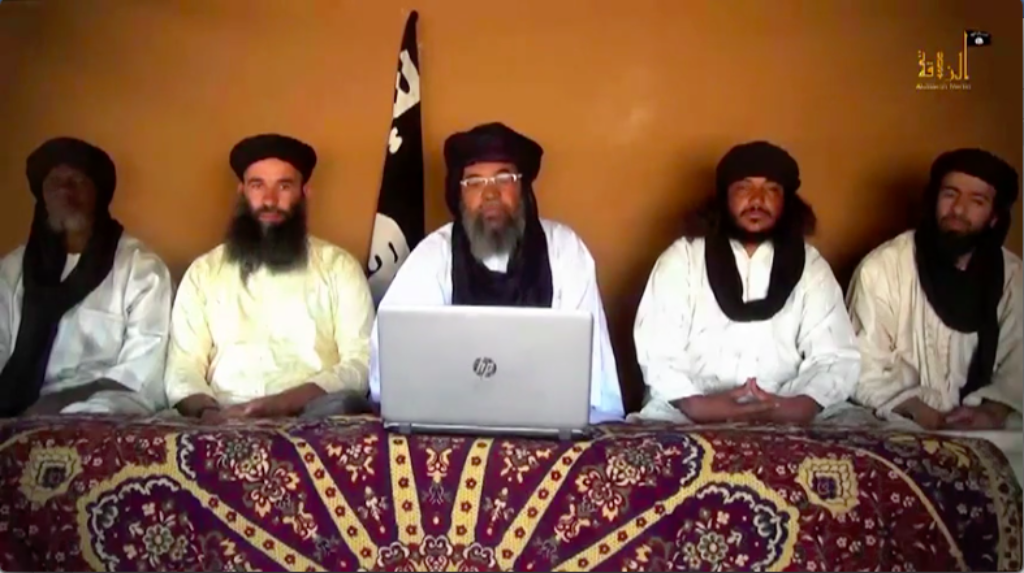
On Mar. 2, a merger of al Qaeda groups in the Sahel was announced. The “Group for the Support of Islam and Muslims” (Jama’at Nusrat al-Islam wal-Muslimin) brings together four existing al Qaeda organizations under one banner. Ansar Dine, Al Murabitoon and Al Qaeda in the Islamic Maghreb’s (AQIM) Sahara branch are all part of the new entity. The Macina Liberation Front, an arm of Ansar Dine, is as well.
Iyad Ag Ghaly, the longtime leader of Ansar Dine, heads the new joint venture. Ghaly, a Malian Tuareg jihadist, explained why the merger was necessary in a video that is more than seven minutes long. And he emphasized that his group is part of al Qaeda’s international network.
“On this blessed occasion, we renew our pledge of allegiance [bayat] to our honorable emirs and sheikhs: Abu Musab Abdel Wadoud, our beloved and wise sheikh Ayman al Zawahiri and…the emir of the Islamic Emirate in Afghanistan Mullah Haibatullah, may Allah protect them and support them,” Ghaly said.
Ghaly’s stated allegiance is entirely consistent with how al Qaeda’s global network is structured.
Al Qaeda’s bayat
Abu Musab Abdel Wadoud (also known as Abdelmalek Droukdel) is the emir of AQIM. As such, he is responsible for overseeing the jihadists’ efforts throughout North and West Africa on behalf of al Qaeda’s senior leadership. Like other regional emirs, he has sworn an oath of fealty (bayat) to Zawahiri, al Qaeda’s global chief. Zawahiri, in turn, has pledged his own loyalty to the Taliban’s leader, Mullah Haibatullah Akhundzada.
The Taliban named Mullah Haibatullah as its emir in May 2016 after his predecessor, Mullah Mansour, was killed in a US drone strike in Pakistan. Mansour had succeeded Taliban founder Mullah Omar in the post. Omar died in 2013, but the Taliban didn’t admit his death until two years later, in mid-2015.
Al Qaeda’s senior leaders, Osama bin Laden and Ayman al Zawahiri, repeatedly pledged bayat to the Taliban’s emir, dating back to even before the 9/11 hijackings. Although they have been loyal to the Taliban’s chieftain, however, there is little to no evidence that the Taliban directs al Qaeda’s operations outside of Afghanistan. Still, al Qaeda technically receives authorization from the Taliban’s head man to carry out its jihad elsewhere around the world. And al Qaeda refers to Mullah Haibatullah, like Mansour and Omar before him, as “Emir ul-Mu’minin,” or the “Emir of the Faithful,” a title usually reserved for a Muslim caliph.
Ghaly portrays bin Laden’s and Zawahiri’s efforts as a key part of Islamic history. He said that a “group from the people of knowledge and jihad” have “resurrected” the “sunna of the Prophet” within the Islamic ummah (worldwide community of Muslims). Members of this group have “persevered” through harm and never faltered, he said. At the “head” of this group are the “two mujahid sheikhs,” bin Laden and Zawahiri. Ghaly asked Allah to “protect” Zawahiri so he can “raise the banner of jihad against the Crusaders and unite al Qaeda” underneath it.
Although some commentators have written off Zawahiri’s influence, Ghaly’s words underscore the fact that the elderly Egyptian ideologue continues to command the loyalty of jihadists around the globe.
In fact, Zawahiri’s reach has long extended into Africa. He first recognized AQIM as an official branch of al Qaeda in Sept. 2006. A letter recovered during the May 2011 Abbottabad raid, and apparently authored by Osama bin Laden, made it clear that Zawahiri had a large say in managing AQIM. The author (presumably bin Laden) told Droukdel that there were “some obstacles in the correspondence of letters between the brothers and me” at the time. “[S]o when any message is sent to me, please send a copy to Abu Muhammad Sheikh Ayman al Zawahiri; he is in constant contact with the brothers and is in charge of following up the affairs in the Islamic Maghreb,” bin Laden wrote.
In his short video, Ghaly explained his new venture in the context of al Qaeda’s policies. He claimed that al Qaeda has sought unification according to sharia law, drawing lessons from the life of Mohammed, such as “distinguishing between” times of “vulnerability and empowerment.” Ghaly likely meant that al Qaeda has concluded that the full implementation of sharia law is not possible in areas where the jihadists do not have a firm grip on power. It was along these lines that al Qaeda leaders advised AQIM to abstain from strictly enforcing sharia in Mali during its short-lived reign there in 2012. (The jihadists did not fully comply with these instructions.)
Ghaly also praised al Qaeda for its restraint with respect to the issue of takfir, or declaring other Muslims to be infidels. The Islamic State, al Qaeda’s rival, is prolific in this regard.
Constituent groups all part of al Qaeda’s global network
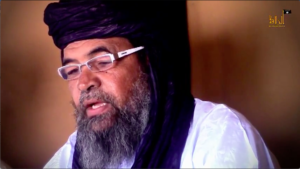
In his Mar. 2 announcement, Ghaly (seen on the right) said that Ansar Dine, Al Murabitoon, and AQIM’s branch in the Sahara had united “into one group” operating under “one emir,” so they could “stand united against the occupier Crusader enemy.”
He did not specifically mention the Macina Liberation Front (MLF), also known as Katibat Macina, but this is probably because the MLF is a part of Ansar Dine itself.
Ansar Dine
Ghaly’s organization was the local face of AQIM in Mali and part of its plan for implementing sharia law in the areas under its control in 2012. A French-led offensive in early 2013 interrupted AQIM’s state-building project. But the experience before the West’s intervention tells us much about al Qaeda’s approach to establishing an Islamic emirate — not just in Mali, but also elsewhere.
The State Department designated Ansar Dine in Mar. 2013, noting that the group “cooperates closely” with AQIM and “has received support from AQIM since its inception in late 2011.” Ansar Dine “continues to maintain close ties” to AQIM and “has received backing from AQIM in its fight against Malian and French forces,” Foggy Bottom reported.
But State’s description did not elaborate on why AQIM stood up Ansar Dine in the first place.
The United Nations has detailed the strategy behind AQIM’s establishment of Ansar Dine. In Oct. 2011, AQIM emir Droukdel “wanted cover to expand the agenda of his terrorist organization into the Sahel and increase its territorial control over northern Mali.” AQIM “wanted to create an ostensibly independent movement that would hide its true roots by abandoning the name” Al Qaeda. Therefore, AQIM “suggested that the new group be led by” Ghaly.
The UN went on to summarize some of the “continual support” Ansar Dine has received from AQIM, including military, financial and logistical assistance. AQIM backed Ansar Dine throughout 2012, as the jihadists battled Malian Armed Forces and captured territory.
By Nov. 2012, Ansar Dine, AQIM and another al Qaeda group, the Movement for Unity and Jihad in West Africa (MUJAO), had formed a “common strategy” and the three coordinated operations against French and Malian forces. (MUJAO merged with yet another al Qaeda sub-group led by Mokhtar Belmokhtar to form Al Murabitoon in 2013, but a part of MUJAO subsequently defected to Abu Bakr al Baghdadi’s Islamic State.)
Captured AQIM documents further illuminate al Qaeda’s strategy and the role played by Ansar Dine.
In one such letter, first uncovered by Rukmini Callimachi, who was then reporting for the Associated Press, Droukdel addressed Ansar Dine’s shura council members. Droukdel explained that the West could easily topple a new Islamic emirate in Mali, and he didn’t want the people to blame the jihadists if this happened. So Droukdel wanted to use AQIM’s advances in the region to build broader popular support for the jihadists’ agenda and “extend bridges to the various sectors and parts” of society, including Arabs, the Tuareg people, and other Africans. He surmised that would make it easier for al Qaeda to re-establish a Islamist government in the future. To the extent possible, Droukdel also did not want the jihadists’ governance efforts to appear foreign to the local populace.
That is why Ansar Dine was a key part of AQIM’s plans.
Droukdel concluded in his letter that AQIM had “two missions” and combining them created a “true dilemma.” AQIM wanted to both preserve the effort to build an Islamist state, and also continue its “global jihadi project.” The latter is a reference to AQIM’s commitment to carrying out terrorist operations throughout the region, particularly against Western forces, and possibly elsewhere.
According to the letter, Droukdel and his advisers came up with two proposals. In the first scenario, AQIM would subordinate itself to the local ruler. AQIM would “be under the emirate of Ansar Dine” such that AQIM’s “emir would follow their emir” and AQIM’s “opinion would follow their opinion.” This would be the case for all “internal activity,” meaning “all activity connected to participating in bearing the responsibilities of the liberated areas.” But all “external activity” connected to the “global jihad…would be independent of them (Ansar Dine)” and AQIM “would ensure that none of that activity or its repercussions are attributed to them [Ansar Dine], as care must be taken over negative impacts on the project of the state.”
In Droukdel’s “second proposal,” some of al Qaeda’s mujahideen “would be set aside and put under the complete control of the emir of Ansar Dine to participate in bearing the burden of running the affairs of the liberated cities.” The remaining al Qaeda members would be “completely independent of Ansar Dine and its activity would be limited to jihadi action outside the region.”
AQIM never got the opportunity to fully pursue either of these proposals. Just as Droukdel warned, the West quickly overran the jihadists’ proto-emirate. Still, it is telling that Droukdel was willing to subordinate AQIM and its brand to Ansar Dine in the service of building a new Islamic emirate. And he was also keen to keep AQIM’s “external” plotting separate from the mission of the nascent state – a telling indication that al Qaeda’s plots against Western forces can complicate its strategy for building emirates.
[For more on AQIM’s state-building strategy in North and West Africa, see FDD’s Long War Journal report, Libya’s Terrorist Descent: Causes and Solutions.]
Al Murabitoon
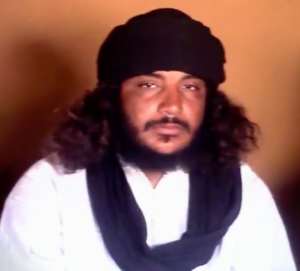
Al Murabitoon’s deputy leader, Hassan Al Ansari (seen on the right), appeared alongside Ghaly in the Mar. 2 video. Ansari’s appearance only adds to the mystery surrounding Mokhtar Belmokhtar’s status. Belmokhtar is Al Murabitoon’s leader, but he has been reported dead several times in the past. US officials are not certain whether he is dead or alive.
The jihadists are acting as if Belmokhtar is still in this world and have released a number of written statements in his name. For example, Belmokhtar supposedly authored a eulogy for a prominent Tuareg leader, Sheikh Ag Aoussa, in October of last year.
Al Murabitoon reunited with AQIM in late 2015. And Ibrahim al Qosi, a senior Al Qaeda in the Arabian Peninsula (AQAP) official who was once held at Guantanamo, praised Belmokhtar for the merger. In a message released in Dec. 2015, Qosi credited Belmokhtar with putting the interests of the ummah ahead of his own private concerns, so that the “Crusader-Shiite” campaign could be confronted with “one sword.”
However, Belmokhtar has not released a proof of life audio or video in quite some time. And his absence from Ghaly’s video will only fuel speculation about the one-eyed jihadist’s fate.
AQIM in the Sahara
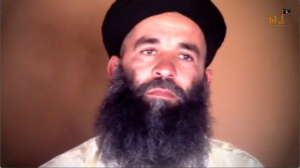
Sitting to Ghaly’s right in the video was Yahya Abu Hammam, a longtime AQIM commander who was designated as a terrorist by the US Treasury Department in Feb. 2013. (He can be seen in the screen shot on the right.) Hammam, also known as Jamel Akacha, has been AQIM’s chief commander in the Sahel for several years. In that capacity, and beforehand, he has been involved in AQIM’s kidnapping operations. The US has offered a $5 million reward for information on Hammam’s whereabouts.
A second AQIM official, Abu Abdul Rahman al Sanhaji, also appeared alongside Ghaly and the others. Sanhaji is a prominent AQIM sharia official and has appeared in hostage videos and other productions as a supposed religious authority.
The Macina Liberation Front (MLF)
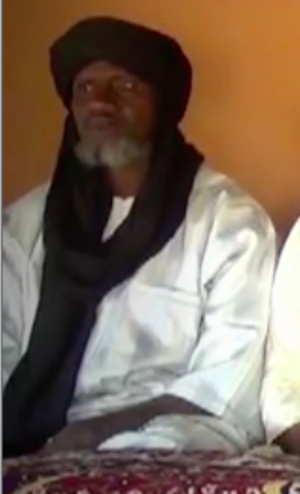
The final jihadist attending Ghaly’s announcement was Amadou Kouffa (seen on the right), the leader of the MLF. Kouffa has been one of Ghaly’s staunchest allies in the region. According to a report prepared by the Canadian Security Intelligence Service (CSIS), Kouffa was a “local Peul [Fula or Fulani] imam.” CSIS referred to Kouffa’s group as “Ansar Dine Macina,” thereby highlighting the fact that the MLF was really just an extension of Ansar Dine. Kouffa’s “forces,” backed by Ghaly, helped lead “the Islamist advance in late 2012 towards Mopti, triggering the French intervention” and they have “conducted attacks across central Mali” since then.
Kouffa’s ranks have increased with the recruitment of “Peul fighters, many of whom fought under the leadership of Belmokhtar and Ould Kheirou [a MUJAO leader] in the Gao region in 2012,” CSIS noted. The MLF has worked to implement sharia law, portraying the jihadists’ belief system as the best way to check abuses by local authorities.
Ghaly praised formation of Hay’at Tahrir al Sham for the sake of “unity”
Although he didn’t specifically name the group, Ghaly praised the creation of Hay’at Tahrir al Sham (HTS) in January. Addressing “our mujahideen brothers in Syria,” Ghaly said: “You represent a good example of unity, merging, and relinquishing personal interests for the sake of the ummah’s interests.” Ghaly said that the “ummah…rejoices at your efforts toward merging” and the Syrian mujahideen’s “unity” has gained “the ummah’s supplications on your behalf.”
Al Qaeda stressed the theme of “unity” when HTS was announced and thereafter. HTS brought together Jabhat Fath al Sham (formerly known as Al Nusrah) and four other groups. Multiple factions have reportedly joined HTS in the weeks since.
For al Qaeda, “unity” serves multiple purposes, including: strengthening the jihadists’ cause, masking the extent of al Qaeda’s influence, making it more difficult for the West to isolate al Qaeda for counterterrorism purposes and thwarting the Islamic State’s attempts to earn the loyalty of more potential defectors. Therefore, it is especially interesting that Ghaly invited a comparison between his own organization and HTS.
However, there are some key differences between HTS and the newly formed “Group for the Support of Islam and Muslims.” For starters, the latter is openly loyal to Zawahiri, while HTS has attempted to mask any organizational affiliations. The constituent groups in Ghaly’s enterprise all had known, direct ties to al Qaeda’s network prior to their merger earlier this month. But HTS’ signatories included organizations that were not explicitly al Qaeda formations.
In some ways, HTS is following the model set forth in the letter written by Droukdel that is discussed above. HTS is focused on the jihad against Bashar al Assad’s regime and its ultimate goal is to build an Islamic emirate in Syria. HTS has tried to distance itself, at least rhetorically, from al Qaeda’s anti-Western brand. It is likely that other al Qaeda actors in Syria still have an eye on the West — that is, “external” operations. From al Qaeda’s perspective, it is crucial that these “two missions,” as Droukdel described it, be seen as distinct. Otherwise, the jihadists’ state building project will attract even more unwanted attention.
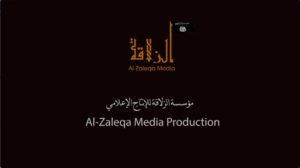
During his speech, Ghaly referred to a Koranic text which tells Muslims to “hold fast, all together, by the rope which Allah stretches out for you, and be not divided among yourselves.” Al Qaeda uses this passage to stress its idea of “unity” in general, and also in the face of the challenge posed by Baghdadi’s men.
Careful observers will note that Ghaly’s “Group for the Support of Islam and Muslims” uses a flag that is very similar to the Islamic State’s. The flag stood behind Ghaly as he spoke. It is also used as part of the logo for Al Zaleqa Media, the propaganda arm that produced Ghaly’s video.
But the flag is not the Islamic State’s sole possession. Al Qaeda branches, such as AQAP, have regularly used a similar banner.
And as Ghaly made clear, he and his men remain in Ayman al Zawahiri’s camp.







